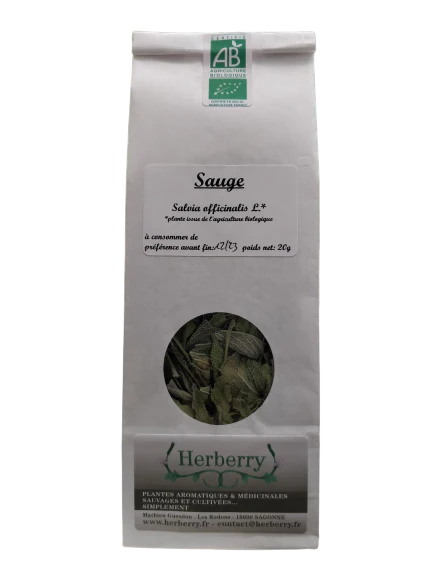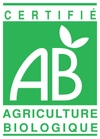
Officinal sage for herbal teas-20g-Herberry
Remaining stock : 10


Sage leaves
Discover the product Sage officinale for herbal teas in a 20g sachet from Herberry.
Why use Herberry Sage leaves?
Properties:
-Promotes bile secretion and thus helps reduce bloating, flatulence, digestive discomfort and slow digestion.
-Helps reduce hot flashes.
-Reduces excessive sweating.
-Promotes bone remineralization during menopause.
-Promotes menstrual well-being, especially during the premenstrual period, and hormonal balance.
-Stimulates the body's defenses
-Protects cells against oxidative stress.
Most produced:
+Certified organic farming.
+Made in France. Picked in France.
What is the officinal sage of Herberry herbal teas?
Common sage (Salvia officinalis) is a sub-shrub of the Lamiaceae family, often cultivated in gardens as a condiment and medicinal plant or simply for the beauty of its foliage and flowers. It is also called sacred herb or European tea.
It is a very branched plant, with square-section stems and a lignified base. The petiolate leaves are pale green, velvety, oblong. The flowers, on erect flower stalks, are grouped in small glomeruli.
How to use Herberry herbal tea from Sage Officinale?
1 - How many plants should I put for a cup?
For a 30cl mug, a good pinch of plant (one teaspoon) well crumbled. The more the plant is crumbled, the more flavor and active ingredient there will be in the water.
2 - How long should I let the plants infuse?
Generally 5 minutes of infusion is enough, but for certain plants such as chamomile, do not exceed 3 minutes as it will become bitter.
3 - Can I give it to children?
For children aged 5 to 10 years old the same dose as for an adult, but in a 1/2 cup which will be completed with water.
4 - How many cups can I drink per day?
For a cure, we recommend 3 herbal teas per day for 21 days. It's a maximum.
All the information on the virtues of the simple herbal teas that you will find under the Herberry brand are taken from several recognized works and traditional knowledge:
“therapeutic plants” by Max Wichtl and Robert Anton,
"The Book of Good Herbs" - "The Book of Trees, Shrubs and Shrubs" - "The Companion Plant" by Pierre Lieutaghi,
“our grandmothers knew” by Jean Palaiseul,
“bio-indicator plants” by Gérard Ducerf,
“the summary of the history of common plants” by PJB Chomel,
“The path of herbs” by Thierry Thevenin.
These uses, medicinal or food, are based on traditional knowledge validated by their age... They in no way exclude the consultation of a doctor who will have the competence to establish a diagnosis and prescribe an appropriate treatment.
Composition of the product Officinal sage for herbal teas, 20g from Herberry.
100% Sage (Salvia officinalis)

We clean up after ourselves.
Ecommerce deliveries have a carbon footprint. That's why we support verified projects that remove carbon from the air.



Every delivery’s carbon footprint is calculated based on weight, shipping method, and distance traveled. We neutralize these emissions by purchasing verified carbon removal credits from groundbreaking projects.



With your purchase, you’ll join a community of proactive merchants and customers dedicated to a sustainable future. Together, we've removed emissions for over 71 million deliveries and removed over 50 thousand tonnes of carbon.

We work with a network of pioneering carbon removal companies that have been vetted by the commerce platform Shopify.

